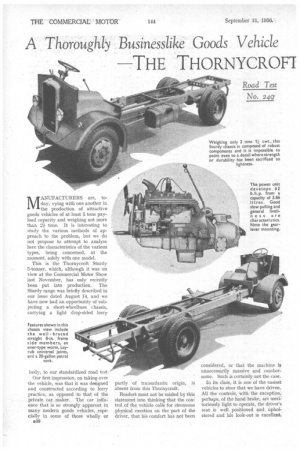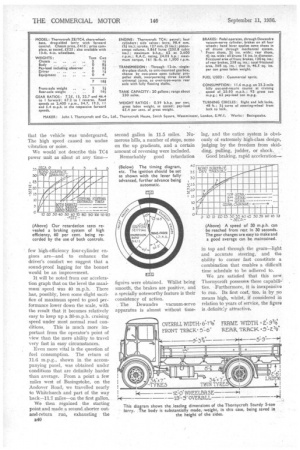A Thoroughly Businesslike Goods Vehicle
Page 48

Page 49

Page 50

If you've noticed an error in this article please click here to report it so we can fix it.
THE THORNYCROFI STURDY
Of New Design, This 3o-m.p.h. 5-tonner was Introduced Last November and is Now in Full Production. Our Tests Show it to be Essentially Roadworthy and Eco
nomical in Operation
MANUFACTURERS are, today, vying with one another in the production of attractive
goods vehicles of at least 5 tons payload capacity and weighing not more than 24 tons. It is interesting to study the various methods of ap proach to the problem, but we do not propose to attempt to analyse here the characteristics of the various types, being concerned, at the moment, solely with one model.
This is the Thornycroft Sturdy 5-tonner, which, although it was on -view at the Commercial Motor Show last November, has only recently
been put into production. The
Sturdy range was briefly described in our issue dated August 14, and we have now had an opportunity of subjecting a short-wheelbase chassis, carrying a light drop-sided lorry
body, to our standardized road test.
Our first impression, on taking over the vehicle, was that it was designed and constructed according to lorry practice, as opposed to that of the private car maker. The car influence that is so strongly apparent in many modern goods vehicles, .espe
cially in some of those wholly or B38
partly of transatlantic origin, is absent from this Thornycroft.
Reader § must not be misled by this statement into thinking that the control of the vehicle calls for strenuous physical exertion on the part of the driver, that his comfort has not been
considered, or that the machine is unnecessarily massive and cumbersome. Such is certainly not the case.
In its class, it is one of the easiest vehicles to steer that we have driven. All the controls, with the exception, perhaps, of the hand brake, are meritoriously light to operate, the driver's seat is well positioned and upholstered and his look-out is excellent. Moreover, the fact that the lorry scales only 2 tons 9i cwt. complete proves that there is no superfluous material in its make-up.
Nevertheless, the frame is strongly built, the main chassis components are well up to their work, and the tyre equipment is generous.
An over-type-worm rear axle is used—a type of final drive not generally employed where low weight is important—and the gearbox pinions have unusually long teeth, ensuring that the load is always shared by at least two on each wheel. The teeth, incidentally, are ground, and the shafts are only 9 ins, long between bearing centres, whilst a noteworthy point is that the gear lever is mounted on a forward extension of the box casting.
Exceptionally rsobust steering gear is a, feature, and although the need for a large wheel does not arise from shortcomings in the other units of the system, this item. is noteworthy for its big diameter.
In respect of the suspension system, the fact that the machine is for business and not for pleasure has-influenced the designer in the selection of springs. These are on the hard side, and, whilst the road shocka created by fast travel over rough roads are not completely absorbed, the risk of the mudguards riding on the tyres is non-existent, and corners can be rounded at speed without roll or other troubles, such as are sometimes induced by soft suspensions.
Of compact design, the high-efficiency engine is, like the chassis. entirely new. The use of four cylinderi is characteristic of the principle of efficiency, combined with simplicity, that underlies the whole vehicle.
Among its main features are the employment of a single casting for the cylinder block and crankcase; the crankpin and main-journal diameters —2i ins, in both cases; inserted exhaust-valve seatings; dry cylinder liners ; Thornycroft-made aluminiumalloy pistons, and a Ricardo-type east-iron head.
The camshaft operates the side valves through inverted-mushroomtype tappets, and is driven by a triple-roller chain, which also runs the dynamo, this being adjustable for
chain tensioning. Coil ignition is used, and, in standard form, no. starter is provided, this being avails able for £13 extra. At all timesdur-. Mg. our test starting up was effected by hand with ease.
The water pump incorporates a carbon gland, and, despite its high mounting, is quite effective, as was proved by our 1.1-mile climb of Fairleigh Hill, near Basingstoke, which has a maximum gradient of-1 in S.
In ascending this acclivity, after 0.6 mile against collar in top gear, 0.2 mile required third speed. Then the second and first ratios were employed for 0.1 mile each, the final • and steepest stretch being covered at about 10 m.p.h. Nevertheless, at the summit a water temperature of only 178 degrees F. was recorded. In descending its lower slopes, for a brief spell a speed approaching 50 m.p.h. was touched. We mentibn. this because • it dispelled from or mind an impression, formed earlier, tk39 few high-efficiency four-cylinder engines are—and to enhance the driver's comfort we suggest that a sound-proof lagging for the bonnet would be an improvement.
It will be noted from our acceleration graph that on the level the maxi muni speed was 40 M.p.h. There has, possibly, been some slight sacri fice of maximum speed to good performance lower down the scale, with the result that it becomes relatively easy to keep up a 30-m.p.h. cruising speed under most normal road con
ditions, This is much more important from the operator's point of view than the mere ability to travel
very fast in easy circumstances.
Even more vital is the question of fuel consumption. The return of 11.6 m.p.g„ shown in the accompanying panel, was obtained under conditions that are definitely harder than average. From a point a few miles west of Basingstoke, on the Andover Road, we travelled nearly to Whitchurch and part of the way back-11.7 miles—on the first gallon. We then regained the starting point and made a second shorter out and-return run, exhausting the 1340 fignres were obtained. Whilst being smooth, the brakes are positive, and a specially noteworthy feature is their consistency of action.
The Dewandre vacuum-servo apparatus is almost without time
in top and through the gears—light and accurate steering, and the ability to corner fast constitute a combination that enables a difficult time schedule to be adhered to. We are satisfied that this new
Thornycroft possesses these capabili
ties. Furthermore, it is inexpensive to run. Its first cost, too, is by no means high, whilst, if considered in
relation to years of service, the figure is. definitely attractive.




















































































